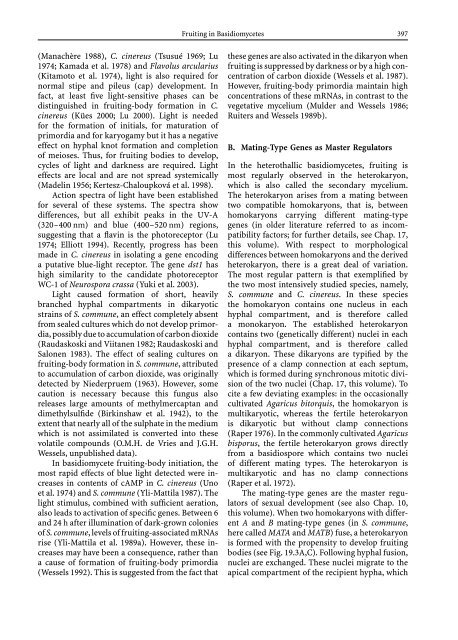Growth, Differentiation and Sexuality
Growth, Differentiation and Sexuality
Growth, Differentiation and Sexuality
You also want an ePaper? Increase the reach of your titles
YUMPU automatically turns print PDFs into web optimized ePapers that Google loves.
(Manachère 1988), C. cinereus (Tsusué 1969; Lu<br />
1974; Kamada et al. 1978) <strong>and</strong> Flavolus arcularius<br />
(Kitamoto et al. 1974), light is also required for<br />
normal stipe <strong>and</strong> pileus (cap) development. In<br />
fact, at least five light-sensitive phases can be<br />
distinguished in fruiting-body formation in C.<br />
cinereus (Kües 2000; Lu 2000). Light is needed<br />
for the formation of initials, for maturation of<br />
primordia <strong>and</strong> for karyogamy but it has a negative<br />
effect on hyphal knot formation <strong>and</strong> completion<br />
of meioses. Thus, for fruiting bodies to develop,<br />
cycles of light <strong>and</strong> darkness are required. Light<br />
effects are local <strong>and</strong> are not spread systemically<br />
(Madelin 1956; Kertesz-Chaloupková et al. 1998).<br />
Action spectra of light have been established<br />
for several of these systems. The spectra show<br />
differences, but all exhibit peaks in the UV-A<br />
(320–400 nm) <strong>and</strong> blue (400–520 nm) regions,<br />
suggesting that a flavin is the photoreceptor (Lu<br />
1974; Elliott 1994). Recently, progress has been<br />
made in C. cinereus in isolating a gene encoding<br />
aputativeblue-lightreceptor.Thegenedst1 has<br />
high similarity to the c<strong>and</strong>idate photoreceptor<br />
WC-1 of Neurospora crassa (Yuki et al. 2003).<br />
Light caused formation of short, heavily<br />
branched hyphal compartments in dikaryotic<br />
strains of S. commune, an effect completely absent<br />
from sealed cultures which do not develop primordia,<br />
possibly due to accumulation of carbon dioxide<br />
(Raudaskoski <strong>and</strong> Viitanen 1982; Raudaskoski <strong>and</strong><br />
Salonen 1983). The effect of sealing cultures on<br />
fruiting-body formation in S. commune, attributed<br />
to accumulation of carbon dioxide, was originally<br />
detected by Niederpruem (1963). However, some<br />
caution is necessary because this fungus also<br />
releases large amounts of methylmercaptan <strong>and</strong><br />
dimethylsulfide (Birkinshaw et al. 1942), to the<br />
extent that nearly all of the sulphate in the medium<br />
whichisnotassimilatedisconvertedintothese<br />
volatile compounds (O.M.H. de Vries <strong>and</strong> J.G.H.<br />
Wessels, unpublished data).<br />
In basidiomycete fruiting-body initiation, the<br />
most rapid effects of blue light detected were increases<br />
in contents of cAMP in C. cinereus (Uno<br />
et al. 1974) <strong>and</strong> S. commune (Yli-Mattila 1987). The<br />
light stimulus, combined with sufficient aeration,<br />
also leads to activation of specific genes. Between 6<br />
<strong>and</strong> 24 h after illumination of dark-grown colonies<br />
of S. commune, levels of fruiting-associated mRNAs<br />
rise (Yli-Mattila et al. 1989a). However, these increases<br />
may have been a consequence, rather than<br />
a cause of formation of fruiting-body primordia<br />
(Wessels 1992). This is suggested from the fact that<br />
Fruiting in Basidiomycetes 397<br />
these genes are also activated in the dikaryon when<br />
fruiting is suppressed by darkness or by a high concentration<br />
of carbon dioxide (Wessels et al. 1987).<br />
However, fruiting-body primordia maintain high<br />
concentrations of these mRNAs, in contrast to the<br />
vegetative mycelium (Mulder <strong>and</strong> Wessels 1986;<br />
Ruiters <strong>and</strong> Wessels 1989b).<br />
B. Mating-Type Genes as Master Regulators<br />
In the heterothallic basidiomycetes, fruiting is<br />
most regularly observed in the heterokaryon,<br />
which is also called the secondary mycelium.<br />
The heterokaryon arises from a mating between<br />
two compatible homokaryons, that is, between<br />
homokaryons carrying different mating-type<br />
genes (in older literature referred to as incompatibility<br />
factors; for further details, see Chap. 17,<br />
this volume). With respect to morphological<br />
differences between homokaryons <strong>and</strong> the derived<br />
heterokaryon, there is a great deal of variation.<br />
The most regular pattern is that exemplified by<br />
the two most intensively studied species, namely,<br />
S. commune <strong>and</strong> C. cinereus. In these species<br />
the homokaryon contains one nucleus in each<br />
hyphal compartment, <strong>and</strong> is therefore called<br />
a monokaryon. The established heterokaryon<br />
contains two (genetically different) nuclei in each<br />
hyphal compartment, <strong>and</strong> is therefore called<br />
a dikaryon. These dikaryons are typified by the<br />
presence of a clamp connection at each septum,<br />
which is formed during synchronous mitotic division<br />
of the two nuclei (Chap. 17, this volume). To<br />
cite a few deviating examples: in the occasionally<br />
cultivated Agaricus bitorquis, the homokaryon is<br />
multikaryotic, whereas the fertile heterokaryon<br />
is dikaryotic but without clamp connections<br />
(Raper 1976). In the commonly cultivated Agaricus<br />
bisporus, the fertile heterokaryon grows directly<br />
from a basidiospore which contains two nuclei<br />
of different mating types. The heterokaryon is<br />
multikaryotic <strong>and</strong> has no clamp connections<br />
(Raper et al. 1972).<br />
The mating-type genes are the master regulators<br />
of sexual development (see also Chap. 10,<br />
this volume). When two homokaryons with different<br />
A <strong>and</strong> B mating-type genes (in S. commune,<br />
here called MATA <strong>and</strong> MATB) fuse, a heterokaryon<br />
is formed with the propensity to develop fruiting<br />
bodies (see Fig. 19.3A,C). Following hyphal fusion,<br />
nuclei are exchanged. These nuclei migrate to the<br />
apical compartment of the recipient hypha, which

















